The Kate and her companions who brought immigrants into Brisbane.
Stephanie Ryan
State Library of Queensland
A researcher was intrigued to learn that her ancestors, who arrived by the Susanne Godeffroy and Melmerby in 1865, Wansfell in 1866 and Royal Dane in 1869, all made the trip from Moreton Bay to Brisbane in the Kate. What was the Kate? What was the journey from the bay to Brisbane like?
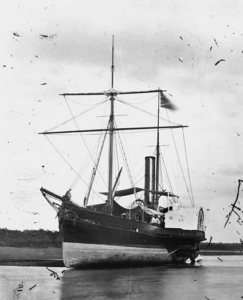
Paddle Steamer ‘Kate’ at Gladstone ca 1870. Image held at the John Oxley Library, State Library of Queensland.
The Kate, a 150-ton iron, paddle-wheel steamer especially designed for Brisbane’s bay and river trade, was built in 1864 at Newcastle-on-Tyne for J and G Harris who were involved in Brisbane wharfage, transport and cargo inter alia. The Kate had two holds, a large cargo deck and roomy accommodation “fitted up plainly.” She was especially powerful to allow towing of other craft. J and G Harris advertised her sale before she had even arrived. They used her on the Ipswich run but after the Government bought the vessel in 1865, she did government work including transporting government officials to immigrant ships and migrants to Brisbane, towing migrant ships and supplying migrants’ needs before they reached port.
Most migrant ships could not come into the Brisbane River because it was too shallow beyond the bay. While an account of the steamer trip from the bay to Brisbane on the Kate in the 1860s was not available, there are reports of other journeys which capture the experience. First impressions and reflections in this transition from one country to another can transcend the assembly of facts such as arrival dates, ship names and immigrant numbers.
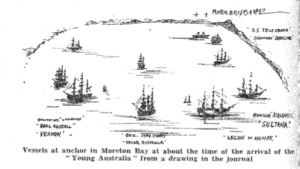
Vessels at anchor in Moreton Bay. Image from Sea Breezes magazine, Queensland State Library. August 1956 p88
William Smith who arrived on the Young Australia in 1864 sketched twelve vessels (Sketches at Sea) including a few smaller boats in the bay, reflecting the immigration surge in the early years after Separation from 1860.
Smith’s travelling companion, Richard Watt, recorded in his diary (reproduced in Sea Breezes 1956 Vol 128 pp 88-91) the anticipation and excitement after anchoring, then waiting in the bay for health clearance and the steamer to Brisbane. “All was bustle to get the ship into order, to receive the officers, and when all was ready the cannon was fired as a signal, and the flags run up to the mastheads. Below, all were packing up their chattels, and as several steamers were seen from time to time in the course of the morning to come down the river towards us, each was supposed by excited individuals to be ‘the’ one to take us to Brisbane.”
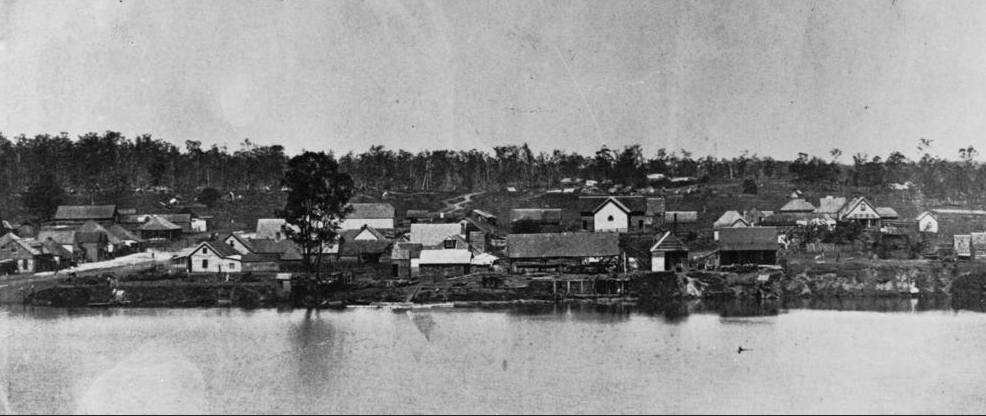
Stretch of the Brisbane River from Hockings Whaft towards South brisbane ca 1868.
This image has been digitised by the State Library of Queensland, and provided to the Wikimedia Commons as part of a cooperative project.
It was noon of that day before the steamer, in this case the Diamond, arrived. It brought the health and customs officers as well as some “sunburnt colonists”, friends or family of the new arrivals. It also brought fresh beef, mutton and new potatoes. After a few hours the vessel left with government officers, the skipper and saloon passengers. The remaining immigrants comforted themselves with abundant fresh food. Two days later, the vessel, Settler, came to take them and luggage into Brisbane. The officials called out the immigrants’ names and asked if they had complaints. Watt said they “smothered their grumblings”, keen to land. When all were on board, the Young Australia fired her gun amid “deafening cheers.”
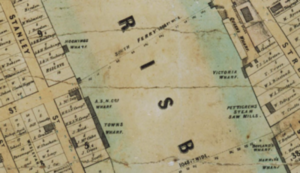
Hams map of Brisbane 1863. State Library of Queensland
On the final part of their immigrant journey, approximately 30 miles from the bay, along the river to the wharves, Watt recorded the view, “At first there was nothing interesting in the low, swampy islands near the mouth, but after winding some four or five miles the scenery was truly beautiful. The gum tree and mangroves became scarcer, and the vegetation began to resemble the ash and poplar trees of home with the addition of the beautiful banana.” They were greeted as they travelled along the river by “little groups of ‘blackfellows’” and “many a brown planter” waving to welcome more “new chums”. He was impressed by the houses and gardens commenting that “all bore at least the aspect of comfort”. He found the birds had “strange plumage” and “made curious noises.”
“The river is most pleasing within a mile of the town where it suddenly sweeps sharply round and as it has steep rocky banks which are overgrown with large evergreen trees, it could make a capital city for artists”.

Looking towards the new military barracks 1863. State Library of Queensland
They landed at Raff’s Wharf where Watt noted there were 4 steamers which would be going separately to Sydney, Melbourne, Rockhampton and Port Denison. The heart of Brisbane along the river, unlike today, was dominated by wharves, warehouses and related businesses. See map below.
The river itself was a heavily trafficked artery for goods and people not least because of the roads – non-existent or very poor.
The town exceeded his expectations, “large and straggling, connecting up North and South Brisbane built for the most part on undulating land…On the summits of the highest rises are built the churches, chapels and the observatory or signal station”. Charles Eden, an arrival by Queen of the South, thought the settlement more “picturesque than flourishing.”[1]
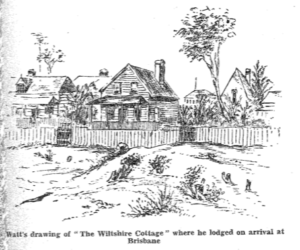
Watts drawing of The Wiltshire Cottage where he lodged on arrival at Brisbane. Image from Sea Breezes magazine, Queensland State Library. August 1956 p91.
Watt describes their arrival at the landing stage “all confusion and bustle” with “excited passengers hauling up their luggage to the wharf” as well as “the meeting of long-parted friends or the disappointment of others” as they learned of the death of those who might have met them.
He describes their luck in meeting a lady who could find room for three at Wiltshire Cottage, lucky because of the many new arrivals.
There was a race to scarce accommodation which meant the ferry boats were busy until late. Charles Eden described the immigration depot as a “large wooden barn” but the Courier describes the immigration accommodation in the early 1860s in harrowing detail.[2] A new life had begun.
[1] Charles Eden link is a pdf download of the book ‘An Eight Years Experience in the above Colony’ by Charles H Eden 1872 London – Longmans, Green, and Co. The download is 26MB
[2] The Courier (Brisbane, Qld 1861-1864. Thurs 1 Oct 1863. Page 2 ‘Our Immigration Depots’

I enjoyed reading your story about the journey from the Bay to the town of Brisbane in that period as that is when my earliest Brisbane ancestors arrived. Thanks for a different slant to our immigrant’s arrivals Stephanie, it makes for an interesting tale.
When researching the arrival of Ancestors in Brisbane during the second half of the 19th Century, the Steamer “Kate” will often be mentioned. This also applies for movement by water within Queensland. There are many stories involving “Kate” which can be told if anyone is interested. Also available is a painting of the Kate in North Queensland as well as an engraving showing what must have been the “Kate”. Each of these have a story behind them which might interest someone.
Thank you for providing further detail Sid.
It was so nice to read your story of the Kate, Stephanie. My great grandfather, Peder Hansen and his family arrived in Moreton Bay in 1878. His wife had died on the voyage and the immigrants from the ship, ‘Friedeburg’ were quarantined on Peel Island for several weeks. It must have been so joyful when the steamer, ‘Kate’ arrived at Peel Island to take them into Brisbane. Thank you for adding some insight into what their arrival along the Brisbane River might have been like.
I am glad you found the comments interesting Ross.
Between September and October 1872, The “Kate” made a voyage up the Coast to the Torres Strait. On board were the Governor, the Marquis of Normanby, his Son, the Premier/Colonial Secretary A.H.Palmer, a photographer and Staff Commander Edward Parker Bedwell. The purpose of the voyage was to annex any islands up to sixty miles off the coast which would place them under the control of the Colony of Queensland. Parliament had previously discovered the rents on at least one island in North Queensland were still being paid to the NSW Government.
Bedwell had been earlier asked by the Governor to accompany the voyage but he declined as it would have taken him away from his surveying duties of parts of the Queensland Coast. What might not be so widely known is that Bedwell became sick when surveying the Brisbane Rover earlier that year. He consulted two of Brisbane’s top Doctors who recommended he return to England immediately or change his employment. He wrote to Admiral Richards the Admiralty Hydrographer in England (and his Captain previously on HMS Hecate and HMS Plumper in Canada). He stated in his letter he would return to London via America and that he thought Lieutenant Jeffreys could take over his work. Four days later he sent two telegrams to Admiral Richards stating he now wished to remain in his work in Brisbane. He had taken time off his work ,did some painting and now felt recovered. He also thought that the voyage on board “Kate” with the Governor would be relaxing so he went along.
During the voyage he painted ( or made sketches which would be later worked up into paintings which was a method he mentioned to Admiral Richards in another letter) two scenes showing the Government Paddlewheel Steamer “Kate”. One showed the boat coaling by the shore in Rockingham Bay near Cardwell and the other showing the “Kate” at Anchor at Somerset in North Queensland. Both paintings are held by the National Library of Australia. The paintings were purchased by the Library in May 1966 from an Auction of Australian paintings in London.
In 1886 Bedwell exhibited seven watercolour paintings at the Colonial and Indian Exhibition in London. I believe two of them were the ones now held at the National Library. The other five titles show that they were from South East Queensland and mostly in and around Brisbane.
Wouldn’t it be great to find them.
It would Sid
I’ve checked the Australian National Maritime Museum index of ship pictures as well as the Greenwich Museum catalogue without success. I’ve also checked auction catalogues but found nothing for S-E Queensland paintings done by Bedwell. If you know the titles please pass these on.
I rang Bill Kitson, the first curator of the Queenslasnd Museum of Lands, Mapping and Surveying who is interested in pursuing the search further. If you ring me at the State Library, Monday, Wednesday or Friday, I can pass on contact details for him. it’s an interesting part of our history.
Hi Stephanie,
Thank you for your reply. I will call you. I have been researching Edward Parker Bedwell in as much detail as I can find to try to recreate his life ( originally concentrating on his time in Queensland although it didn’t take long for the search to widen). I also am attempting to place each of his paintings to a particular period in his Royal Navy service record. He appears to have been an important part of the surveying of our coast line. It would be a shame for his story to disappear as time goes on.
The John Oxley Library in my opinion must have so many treasures of important people and events in Queensland’s history. Edward Parker Bedwell ‘s place would be down the list but I would like to briefly mention a couple of items about him which grabbed my attention:-
The Library has a couple of boxes titled “The Bedwell Family Papers” TR2052. Among them are his drawing instruments.
Also, in the first half of 1872 he went to Sydney to fine tune the finishing touches for the new steam launch “Sabine” which he had ordered. While there he had the Surveying Schooner “Pearl” overhauled as it hadn’t been maintained for four years. The “Pearl” towed the “Sabine” back to Brisbane, they ran in to big seas North of Coffs Harbour and when the “Sabine” was almost submerged by large waves, he thought it prudent to put in to the Clarence River to shelter. No doubt the charts he was using would have been the ones he helped survey six or seven years previously.
In one of the books is a coloured sketch of the “Pearl” towing the “Sabine” in heavy seas. The only images of either boat i have been able to locate.
Also in one of the books is a series of sketches of a woman reading or sleeping. Maybe 8 to 10 of them. Because of the very personal nature of the sketches, the woman in my opinion can only have been his wife Emily. They would be dated circa 1882 shortly before he retired from the RN. Almost certainly they would have been drawn when he was living at New Ferry beside the River Mersey in England.
In my previous message i mentioned the voyage of the “Kate” where Bedwell went with the Governor and Premier and others to claim the coast islands for Queensland. The photographer on board took almost 100 photographs during the voyage. I firmly believe a considerable number of them are held at SLQ.
By comparing some of the Trove newspaper reports (one in Rockhampton even lists the titles of the photographs) i have matched some of them. Some in SLQ collection are credited to Richard Daintree but the Rockhampton newspaper report mentions copies of the photographs were going to be given to Daintree to show at an exhibition in London. I have started a list to see if i can match a photograph to the description but i have been sidetracked which is a not uncommon occurrence for me. To give you an example, there are three photographs of the steamer “Kate”. One of them shows her aground and all three are at Gladstone. I believe they match descriptions in the Newspaper Articles.
There is another photograph showing a group of men standing on the “Kate” from 1869. Governor Blackall was one of the men. Edward Parker Bedwell is shown on the deck of the ship.
Bedwell also had a ship mate who was a good friend. Bedwell was a witness at his wedding in Sydney. His name was John Gowlland who did the same work as Bedwell but in NSW. Tragically he was drowned in Sydney Harbour. In the first part of 1872 he was instructed to take the Steamer “Governor Blackall” up to Cardwell to search for survivors of the “Maria” and members of the New Guinea Expedition. The ship was wrecked of rocks and some of the survivors were killed by natives. SLQ has his original Journal and report of this voyage.
Lastly, (if you are still reading this) re the “Kate”. In 1881 two of the Royal Princes came to Brisbane with The Detached Squadron which was on a round the world voyage to fly the flag. The “Kate” was used to ferry the regal party from the ships anchored in Moreton Bay upriver to festivities in Brisbane. There is a lithograph of the departure of the squadron on the calm side of Moreton Island. “Kate” steamed along in front of the line of ships taking the review. I believe the Lithograph shows “Kate” doing this. The Queensland Government produced a souvenir book which describes the departure and has the lithograph. Reading the book plus the journal of one of the squadron ships gives a very good idea of this event.
Sid Toomey
Hi Stephanie,
Information on the 1886 Indian and Colonial Exhibition you asked for. The initial information came to me courtesy of Windsor and Districts Family History Society Brisbane when they sent me an addenda for the exhibition which listed six paintings . From this i found the official catalogues on both Internet Archive (archive.org) and also Biodiversitylibrary.org
GROUP 1 – FINE ARTS.
Class 1.
Paintings and Drawings
2a. BEDWELL, E.P. of Westbourne
(1) View in Botanical Gardens, Brisbane.
(2) Merehaye.
(3) View on the Mary River.
(4) Somerset, Port Albany, 1872.
(5) Bank residence, near Ipswich.
(6) Queensland Government Steamer,” Kate”.
(7) Bush Inn, Goodna.
My thoughts on the above items.
I believe (4) & (6) would be the two paintings held in the National Library of Australia. The Library purchased these from an Auction of Australian paintings in London. When they gave me the information, they mentioned there was no further information on the two they hold . I think they must have been able to refer to a catalogue to know this. I wonder if there were any other paintings in the catalogue with titles like those listed above ?
(3) E.P. Bedwell did surveying of the Wide Bay area and the Mary River so that would match.
(2)”Meerhaye”. Also spelt “Merehaye”.
In 1879 Bedwell bought this house and 8 acres. It was located as part of an original 20 acre block which had Chalk Street Lutwyche as its northern boundary and Bridge Street as Eastern Boundary. The train line (not built yet in 1879) also was its Eastern Boundary. On Christmas Eve, 1879 he sat down to dinner with His wife Emily, Harry Harrison his Step Son, His other Son Edward Parker Bedwell 3rd and Brother in law William Howarth Ackerly from Goodna, (Member of Qld Defence Forces, Magistrate, and future Chairman of Purga Council (Haven’t checked this part yet). There was a letter for him but Emily wouldn’t let him read it until dinner was finished. After dinner he read the letter from the Treasury Department informing him the Queensland Government were not going to continue with the shared cost arrangement with the Admiralty on surveying the coast and “he was not to incur any more expense forthwith”. The family were understandably upset at the way the ending was carried out after almost 18 years of service. He had four written Testimonials to the manner in which he worked. Three from Queensland Governors and one from the Administrator who stood in when Governor Kennedy went on leave.
The House “Meerhaye” still stands although it is now combined with another house which was joined to it sometime between 1920 and the end of WW2. The two parts of the house have two distinctive styles. “Meerhaye” is on the left. (Information from Windsor and Districts Historical Society.
(5) I think it likely this would be a house owned by someone named “Bank” which Bedwell or his Brother in Law Ackerly had something to do with. Location is possibly from Goodna heading towards Ipswich. Ackerly lived at Six Mile Creek. His house is still standing. Bedwell married his wife Emily at Ackerly’s house at Goodna in 1877. Three days later they were on a boat back to England for 12 months leave.
(7) I think this Inn would be one of supposedly three trading in the area along the old Brisbane Road. One of them was a Cobb and Co stop off point.
In one of my previous replies i mentioned that i believed some of the photographs held by SLQ were actually taken by the photographer on board “Kate” during the 1872 “Annexation Cruise to Torres Strait”. His name was Frederick Hughes Rogers. The photograph of “Kate” aground shown above at the beginning of Stephanie’s article is one of them.
During the “Annexation” Cruise, “Kate” left the wharf in Gladstone approximately 10-30am on Thursday September 5th. They were soon delayed for several hours in the narrows after becoming stranded by the tides. “The passengers amused themselves”.
This photograph is part of an album of Richard Daintree photographs at SLQ. Some of the other photographs in the album also appear to match ones from this voyage.
On the voyage up to Torres Strait and again on the return journey, “Kate” stopped at Cardwell. The Governors party made an overland voyage to open the Gairloch sugar mill. Photographs were taken during this trip. Some of the photo descriptions match ones at SLQ.
Another photograph at SLQ and also described in the voyage reports amused me and was probably of particular interest to Staff Commander Edward Parker Bedwell. in his surveying capacity he and his men would have taken soundings of the depth of rivers from small boats. They also camped on riverbanks and placed timber markers on riverbanks to use as fixed reference points when triangulating positions to use on the new charts. (They sometimes became frustrated with these markers because after a marker was placed and the men returned to the boats, a local native would appear from the scrub, grab the marker and disappear in to the scrub again). Although history books do not give an explanation for this practice, i believe that being in the tropics , every Queenslander would probably know what a mud crab tasted like. The locals were just protecting their secret spot.
The photograph which would have interested Bedwell is titled “Two Hunters posing with a dead crocodile near Rockhampton Circa 1872”. The photograph was also described in the voyage. It was 22 and a half feet long. It came from the local area.